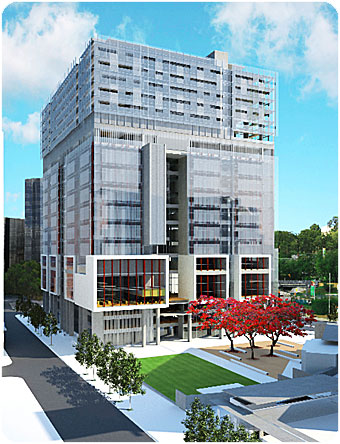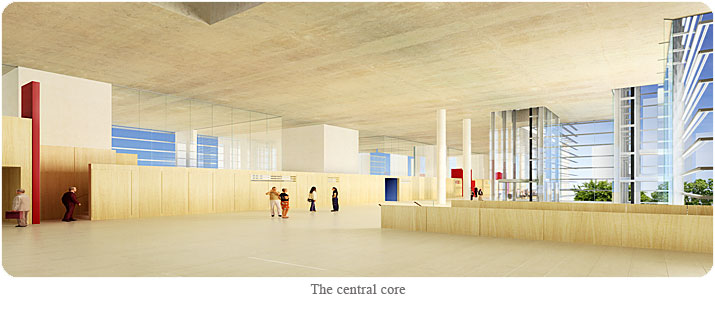Building Information
The design was selected in an architectural competition in 2007. The architects are Architectus with Guymer Bailey (both Brisbane firms).
The managing contractor is Lend Lease and construction started in September 2008.
The project budget is $570 million and it is directly funded by the Queensland Government. The project will be delivered on budget.
The building floor space is approx 60,000 m2. This is almost twice the size of the existing Supreme Court and District Court buildings.
A new public square of approximately 2,500 m2 has been created between the Supreme Court and District Court and the Brisbane Magistrates Court. The square includes a grassed area, paving, trees and café.
The building has nineteen floors arranged as follows:
- Two basement floors for parking, cells, storage and plant. The basements extend under the public square.
- Ground, level 1 and level 2 for administration, registry, jury assembly and vulnerable witness.
- Floors 3 to 9 are court floors. On opening there will be thirty-nine courtrooms — Banco Court, Court of Appeal, twenty-four criminal courts and thirteen civil courts.
- Level 10 is fitted out initially with mediation rooms and State Reporting Bureau accommodation and can be converted into additional courtrooms to accommodate future expansion. This would take the total number of courtrooms to forty-five. The current court buildings have thirty two courtrooms.
- Level 12 and part of level 11 are occupied by the Supreme Court Library.
- Floors 13 to 16 are Judges’ chambers with thirty-four chambers for each court. The existing Supreme Court and District Court have a total of forty-four chambers.
 Design Features
Design Features
The architectural vision is an open accessible building with multiple layers between inside and outside to provide light, privacy and protection from sunlight. Particular features are:
- All courtrooms have large external glass walls with direct light penetration.
- All public waiting areas have direct light with extensive views.
- A double skin glass façade with fritting on the outer layer and external, computer-controlled blinds for sun shading, and with internal blinds for glare control.
- Raised floor with displacement air-conditioning, fire sprinklers and data and electrical cabling underfloor.
- Wooden floors in all courtrooms and public areas with ceilings formed by the underside of the structural slab for the floor above.
- A secure public garden on the Roma Street side of building.
- Double height courtrooms for the Banco Court and the Court of Appeal.
- Internal use of glass walls, off-form concrete and hoop pine wall panelling.
Functional Features
The main functional features of the building are:
- All trial courtrooms are available for use by either the Supreme Court or the District Court. Large courtroom size is 190 m2. Standard courtroom size is 160 m2 to 175 m2.
- Each court floor has a standard floor plan of four criminal and two civil courtrooms per floor.
- Separate lifts for empanelled juries, judges, public, persons in custody, and vulnerable witnesses (total of seventeen lifts) with emphasis on vertical transportation to access courts rather than movement along corridors.
- A dedicated jury assembly area with lounge and dining rooms and a dedicated jury room of 32 m2 for each criminal courtroom. All jury rooms have external windows.
- Person in custody area with forty cells and natural light from skylights. One holding cell for each criminal courtroom on court floors.
- All vehicle access to the building is through existing Brisbane Magistrates Court’s entrance which maintains long uninterrupted pedestrian footpaths around the building.
Technological Features
The building has a number of features to assist court proceedings including:
- All courtrooms are able to display digital evidence, with seventeen of those able to take external video witnesses and fourteen able to be set-up for full e-trials (double the capacity of existing buildings).
- All jury rooms can display digital evidence.
- A vulnerable witness suite with four audio visual evidence giving rooms.
- In-court and remote interpreter technology is installed.
Environmental Features
The environmental features of the building are:
- Displacement air-conditioning,
- Natural light in all public areas and courtrooms,
- Low energy lighting with sunlight, time and movement sensors,
- Double skin façade with computer controlled sun blinds,
- Solar cells on roof (although main power supply is still grid),

Public Art and Legal Heritage Museum
The building includes the major artworks from the existing buildings and three major new artworks:
- The three major new artworks are :
- Banco Court wall painting by Sally Gabori ( an indigenous artist from Gulf of Carpentaria)
- Foyer ceiling- large on-ceiling painting by Gemma Smith ( Brisbane artist)
- Public square arc wall- a major installation by Yukio Kusama (internationally known Japanese artist );
- Existing major judicial portraits which are currently in the Banco Court have been reframed and restored, and will be displayed in a more accessible public gallery outside the ceremonial courtroom;
- The large Daws mural on the ground floor of the existing building will also be displayed adjacent to the ceremonial court;
- The well known Themis statue will be repositioned at the Roma Street end of the new building;
- A legal heritage museum to display the Supreme Court Library collection of historical artefacts and host visiting legal history artefacts will be established on the ground floor.
Details of New Artworks
The three major new artworks were selected on the quality of the artwork and their contribution to the building and the city. The works are not intended to include any direct references to themes of justice or the law.
The artists selected are three women artists spanning a range of ages and cultures. Two of the artists — Sally Gabori and Yukio Kusama — are internationally known and one, Gemma Smith, is a young local artist.
Banco Court Wall
Artwork Dibirdib i Country
Artist: Mirdidingkingathi Juwarnda Sally Gabori
About the Artist
Sally Gabori was born around 1924 on Bentinck Island in the Gulf of Carpentaria. In the late 1940’s the island suffered a severe drought and high tides. The low lying island became uninhabitable and the people were moved to Mornington Island. Sally Gabori is one of the last remaining speakers of the Kayardild language of Bentinck Island.
Sally Gabori began painting in 2005. Her work is a depiction of her ancestral country, the law of that land and growing up on Bentinck Island.
The people of Bentinck Island had a simple visual art tradition of body decoration and string crafts. The lack of a strong visual traditional has allowed Sally Gabori to develop her own style that looks deceptively abstract but captures the shifting light and colours of her “story places”- locales on Bentinck Island associated with her family.
She is represented in the National Gallery of Australia, Queensland Art Gallery, National Gallery of Victoria, Musee du Quai Branly Paris and The Aboriginal Art Museum Utrecht Holland. She has exhibited work individually and in group exhibitions throughout Australia and in London and South Korea.
About the Artwork
The painting brings together four beloved places in Sally Gabori’s life: the fig trees near the beach where her mother Mara was born (the grey shape on the left hand side), the adjoining sea country where her brother used to hunt for dugong and where her late warrior and hunter husband fought for women, the beach at Kalthuriy where her mother’s father was born (the yellow shape in the top right) and the billabong at Nyinyilki with its waterlilies and unfailing supply of fresh water (the black and white shape on the right hand side).
The original painting was translated to the wall by Hilary Jackman and Jeph Neale who, in preparation for the work, travelled to Mornington Island to discuss the work with Sally and study her painting technique.
Foyer Ceiling
Artwork Untitled
Artist: Gemma Smith
About the Artist
Gemma Smith was a Brisbane artist at the time of commissioning and painting of the ceiling. In mid 2012 she moved to the United States. She was a student at Queensland University of Technology and Sydney College of the Arts. Her artwork has been exhibited in significant State and national venues such as the Gallery of Modern Art (Queensland), Heide Museum of Modern Art (Victoria) and the Museum of Contemporary Art (Sydney). Gemma’s work will feature as part of a forthcoming exhibition of young Australian abstract artists at the Australian Embassy, Washington, USA.
About the Artwork
The ceiling painting is an abstract study in perspective, space and colour. It unveils the illusive nature of space and viewpoint as it is approached from the main entry way of the Courts. In this work, the interlocking yet fragmented geometry contains both a sense of connectedness and openness.
The hand painted effect on some of the panels is a deliberate attempt to translate the appearance of small scale brushstrokes to the larger scale.
The work was hand painted on the ceiling by Gemma and two assistants .
Public Square Arc Wall
Artwork Thousands of Eyes
Artist: Yukio Kusama
About the Artist
Kusama is a Japanese artist who is arguably one of the most well known women artists throughout the world in the last twenty five years.
She is celebrated as a living legend the world over and due to the raw appeal of her visual language, enjoys great popularity with audiences from all walks of life. She is now, in her ‘80s, actively achieving the pinnacles of a career that has spanned six decades. She has had a recent major international exhibition at the Pompidou Centre in Paris (2011) and at present has a major retrospective of her work in the Tate Modern Gallery London. She has major installations in many world cities including Paris and Tokyo. She has exhibited in all the major international galleries, on numerous occasions at the Queensland Art Gallery/Gallery of Modern Art, and at the Museum of Contemporary Art in Sydney.
About the Artwork
This is the first permanent public artwork by Kusama in Australia.
Like much of her artwork, it uses symbols that can communicate across cultures. The disembodied eye featured in Thousands of Eyes is a symbol that appears in many cultures throughout time and is seen, for example, in ancient Egyptian hieroglyphics and in contemporary art. It is suggestive not only of a watchful public but also omnipotence, enlightenment and inspiration. Kusama reminds us that it is through the experience of sight that our humanity and our empathy for others are instigated and negotiated.
The realisation of the Kusama artwork was complex. The artist’s hand drawn Thousands of Eyes ink drawing was made for Brisbane’s new courts in her Tokyo studio. It required translation into materials and forms that are durable in the public realm and cope with the problems of installation across the unusual sloping arc wall.
Video: Tour of Justice
The Chief Justice recently gave a tour of the new Supreme Court. A video from the tour can be accessed via the Courier Mail website here.




 Design Features
Design Features 